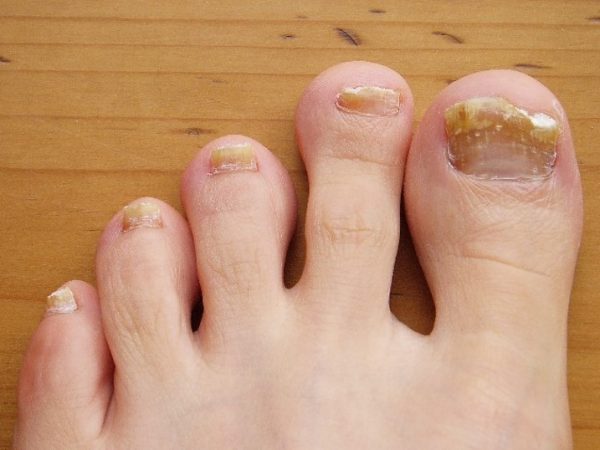
Toenail fungal infection prevention tips
Fungal toenail infection is a common condition that affects millions. It is easy to get infected by fungus in foot. If the infection occurs in foot then the fungus can spread to nails. Anyone can get nail fungus however, some people are at higher risk of getting infected than others.
Medically toenail infection is known as onychomycosis or tinea unguium. It can be contagious and related to poor hygiene.
Symptoms:
- Initial symptom is part of the nail turns white, yellow or brown.
- It starts as a discoloration at the tip of the nail and without treatment discoloration covers the entire nail.
- Under the nail debris builds up and nail starts lifting up without attachment to base skin of toe
- Nail surface turns soft, dry and powdery.
- Eventually nail thins and nail can be scraped
- Sometimes nail can get thicken with discoloration and split
- Generally it is painless but if the fungal infection becomes severe in toenails, wearing shoes can be painful.
Causes:
Generally certain type of fungi are responsible for nail infection. When in skin to skin contact fungal infection spreads from person to person. Walking barefoot in moist, warm area and on dirty fitness floor can cause infection as fungi survive and thrive in such areas. In addition, any wounds, cuts and damage to nail can help fungus to get inside nail. Areas where there is moisture and warm with moist place fungus grows fast.
Lifestyle, age and health conditions can increase the chance of getting nail fungus.
Age: Adults get nail fungus more common than children. With health conditions and reduced immune system to fight infection adults’ body are more prone for microbial infection. In children it is very rare.
Health conditions:
- People who suffer from Athlete’s foot can develop toe fungal infection. In addition, other conditions such as –
- Cancer patients who are receiving chemotherapy
- Diabetic conditions
- Wounded nail or nail surgery
- Psoriasis condition
- Poor blood circulation
- Weak immune system
Lifestyle: If someone is not following proper hygiene system it can result in fungal infection.
- Wet feet or hands
- Sweating
- Smoking
- Spending lot of time in water – working in water, swimming etc
- Walking barefoot in humid and hot place like public shower, swimming pool
- Sports person and athletes in locker room, shower
- Wearing tight clothes, closed shoes with sweaty feet
- Wearing wet socks and not changing socks for many days
- Wearing sneakers that are not washed for longtime
Diagnosis:
Examine your nail and if you see any discoloration and other symptoms talk to your doctor. Sometimes athlete’s foot infection in skin can spread to toe nails. Doctors can tell what type of infection it is after proper examination and by collecting samples.
Treatment:
Trimming and cutting infected nails where there is infection controls the spread. Doctor (dermatologist) might scrape the debris under the infected nail to get rid of some of the fungus.
Mild infections can be treated with low dosage medicines and nail will resume its growth. Toe nails will take about 12 to 18 months to grow back. Applying medicines properly and every day is best solution as controlling fungal growth takes approximately two weeks.
Antifungal cream and antifungal pills are recommended medicines for toe fungal infection. Usually it is two months treatments.
When the nail fungus is hard, combination of both antifungal pills and cream both are essential to get rid of tough infections. ‘
In extreme cases where there is severe infection and no treatment is effective, dermatologist might recommend techniques to get rid of infection where, nail will be removed by using chemical application or removal of nail through surgery. In both types nail will grow back. In rare cases where infections does not go away treating nail is an option where nail cannot grow back.
Maintaining hygiene is critical for fungus to not return on skin and nail.
Ways to control nail fungus: Prevention tips
- Wear flip flops or sandal when walking in warm moist areas
- Throw away shoes, boots and any other foot wear that have come in contact with your nail fungus
- Always wear clean socks. Sprinkle antifungal powder on foot and toes before wearing socks. This will absorb moisture too
- Think of buying moisture-wicking socks
- Always wear shoes that fit properly.
- Do not wear shoes that make your feet sweat and overheat. Dry out shoes by keeping under Sun
- Considering sprinkling antifungal powder in your shoes too
- Cut your nails short- while trimming nails make sure you are not damaging toenails. Keep your toenails shorter. It should be shorter than the end of toes to prevent fungi settling under nail.
- Never share your socks, towels, nail clippers and foot brush
- Always keep your feet dry – after washing legs, use towel to dry off your feet.
- If you have athlete foot infection, consider treatment as soon as possible. If not fungal infection can spread to toes and toe nails.
- Look for any discoloration in toenails and symptoms that are mentioned above. Examine under your feet for infection.
People who has conditions like diabetes, history of cellulitis, psoriasis and other skin conditions must often examine their feet and toenails for any signs of infection.
Toenail fungus is common and can stay for longtime. Cure is possible, however the infection also leads to removal of nails in severe cases. Proper care and hygiene practice of feet, toenails and finger nails are the best solutions to prevent the fungal infection.
References:
Image credit: https://commons.wikimedia.org/wiki/File:Nagelpilz-3.jpg
Attribution: pepsyrock / Public domain
Author: Sumana Rao | Posted on: May 27, 2022
« Protect your vision from Presbyopia or Aging eye WHAT IS F.A.S.T? LEARN ABOUT STROKE »






















Write a comment